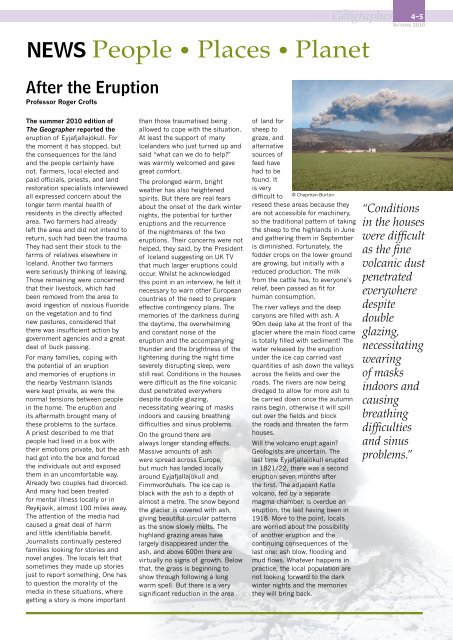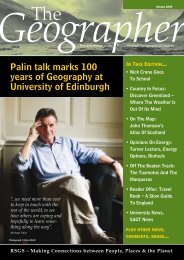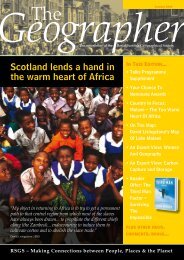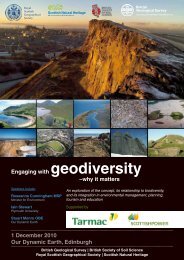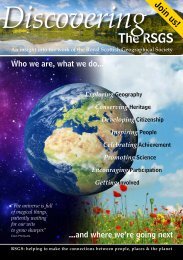Geographer - Royal Scottish Geographical Society
Geographer - Royal Scottish Geographical Society
Geographer - Royal Scottish Geographical Society
You also want an ePaper? Increase the reach of your titles
YUMPU automatically turns print PDFs into web optimized ePapers that Google loves.
NEWS People • Places • Planet<br />
After the Eruption<br />
Professor Roger Crofts<br />
The<br />
<strong>Geographer</strong> 4-5<br />
Autumn 2010<br />
The summer 2010 edition of<br />
The <strong>Geographer</strong> reported the<br />
eruption of Eyjafjallajökull. For<br />
the moment it has stopped, but<br />
the consequences for the land<br />
and the people certainly have<br />
not. Farmers, local elected and<br />
paid officials, priests, and land<br />
restoration specialists interviewed<br />
all expressed concern about the<br />
longer term mental health of<br />
residents in the directly affected<br />
area. Two farmers had already<br />
left the area and did not intend to<br />
return, such had been the trauma.<br />
They had sent their stock to the<br />
farms of relatives elsewhere in<br />
Iceland. Another two farmers<br />
were seriously thinking of leaving.<br />
Those remaining were concerned<br />
that their livestock, which had<br />
been removed from the area to<br />
avoid ingestion of noxious fluoride<br />
on the vegetation and to find<br />
new pastures, considered that<br />
there was insufficient action by<br />
government agencies and a great<br />
deal of buck passing.<br />
For many families, coping with<br />
the potential of an eruption<br />
and memories of eruptions in<br />
the nearby Vestmann Islands<br />
were kept private, as were the<br />
normal tensions between people<br />
in the home. The eruption and<br />
its aftermath brought many of<br />
these problems to the surface.<br />
A priest described to me that<br />
people had lived in a box with<br />
their emotions private, but the ash<br />
had got into the box and forced<br />
the individuals out and exposed<br />
them in an uncomfortable way.<br />
Already two couples had divorced.<br />
And many had been treated<br />
for mental illness locally or in<br />
Reykjavik, almost 100 miles away.<br />
The attention of the media had<br />
caused a great deal of harm<br />
and little identifiable benefit.<br />
Journalists continually pestered<br />
families looking for stories and<br />
novel angles. The locals felt that<br />
sometimes they made up stories<br />
just to report something, One has<br />
to question the morality of the<br />
media in these situations, where<br />
getting a story is more important<br />
than those traumatised being<br />
allowed to cope with the situation.<br />
At least the support of many<br />
Icelanders who just turned up and<br />
said “what can we do to help?”<br />
was warmly welcomed and gave<br />
great comfort.<br />
The prolonged warm, bright<br />
weather has also heightened<br />
spirits. But there are real fears<br />
about the onset of the dark winter<br />
nights, the potential for further<br />
eruptions and the recurrence<br />
of the nightmares of the two<br />
eruptions. Their concerns were not<br />
helped, they said, by the President<br />
of Iceland suggesting on UK TV<br />
that much larger eruptions could<br />
occur. Whilst he acknowledged<br />
this point in an interview, he felt it<br />
necessary to warn other European<br />
countries of the need to prepare<br />
effective contingency plans. The<br />
memories of the darkness during<br />
the daytime, the overwhelming<br />
and constant noise of the<br />
eruption and the accompanying<br />
thunder and the brightness of the<br />
lightening during the night time<br />
severely disrupting sleep, were<br />
still real. Conditions in the houses<br />
were difficult as the fine volcanic<br />
dust penetrated everywhere<br />
despite double glazing,<br />
necessitating wearing of masks<br />
indoors and causing breathing<br />
difficulties and sinus problems.<br />
On the ground there are<br />
always longer standing effects.<br />
Massive amounts of ash<br />
were spread across Europe,<br />
but much has landed locally<br />
around Eyjafjallajökull and<br />
Fimmvorðuhals. The ice cap is<br />
black with the ash to a depth of<br />
almost a metre. The snow beyond<br />
the glacier is covered with ash,<br />
giving beautiful circular patterns<br />
as the snow slowly melts. The<br />
highland grazing areas have<br />
largely disappeared under the<br />
ash, and above 600m there are<br />
virtually no signs of growth. Below<br />
that, the grass is beginning to<br />
show through following a long<br />
warm spell. But there is a very<br />
significant reduction in the area<br />
of land for<br />
sheep to<br />
graze, and<br />
alternative<br />
sources of<br />
feed have<br />
had to be<br />
found. It<br />
is very<br />
difficult to<br />
© Chapman-Burton<br />
reseed these areas because they<br />
are not accessible for machinery,<br />
so the traditional pattern of taking<br />
the sheep to the highlands in June<br />
and gathering them in September<br />
is diminished. Fortunately, the<br />
fodder crops on the lower ground<br />
are growing, but initially with a<br />
reduced production. The milk<br />
from the cattle has, to everyone’s<br />
relief, been passed as fit for<br />
human consumption.<br />
The river valleys and the deep<br />
canyons are filled with ash. A<br />
90m deep lake at the front of the<br />
glacier where the main flood came<br />
is totally filled with sediment! The<br />
water released by the eruption<br />
under the ice cap carried vast<br />
quantities of ash down the valleys<br />
across the fields and over the<br />
roads. The rivers are now being<br />
dredged to allow for more ash to<br />
be carried down once the autumn<br />
rains begin, otherwise it will spill<br />
out over the fields and block<br />
the roads and threaten the farm<br />
houses.<br />
Will the volcano erupt again?<br />
Geologists are uncertain. The<br />
last time Eyjafjallajökull erupted<br />
in 1821/22, there was a second<br />
eruption seven months after<br />
the first. The adjacent Katla<br />
volcano, fed by a separate<br />
magma chamber, is overdue an<br />
eruption, the last having been in<br />
1918. More to the point, locals<br />
are worried about the possibility<br />
of another eruption and the<br />
continuing consequences of the<br />
last one: ash blow, flooding and<br />
mud flows. Whatever happens in<br />
practice, the local population are<br />
not looking forward to the dark<br />
winter nights and the memories<br />
they will bring back.<br />
“Conditions<br />
in the houses<br />
were difficult<br />
as the fine<br />
volcanic dust<br />
penetrated<br />
everywhere<br />
despite<br />
double<br />
glazing,<br />
necessitating<br />
wearing<br />
of masks<br />
indoors and<br />
causing<br />
breathing<br />
difficulties<br />
and sinus<br />
problems.”


